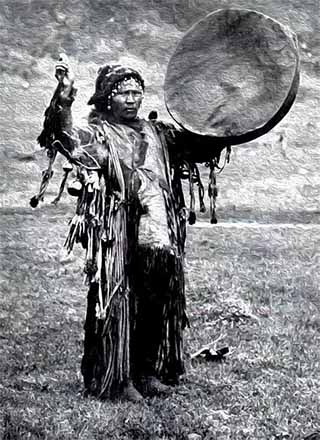Shaman Magician - Shamanism Origin, Rituals And Healing Techniques
Mediator Between the Spiritual and Material World

A shaman magician, also simply called shamanism, is a man endowed with extraordinary spiritual faculties, able to heal the sick, to divert misfortunes and to influence time. A man becomes a shaman by an event that arouses his vocation, via a dream or a vision. Shamans are in direct contact with other worlds and aim to restore the altered relationship between man and divinity. They play the role of mediators between men and the spiritual world.
The Manchu shaman magicians or medicine man

The word shaman means "healer" and "spiritual guide". The term has its origin in the languages of the Manchu-Mongolian ethnic group and was attested for the first time in writing in 1194. This is the term used by the ancestors of the Manchu to designate their sorceresses. Shaman magicians are not tied to a specific religion. In the wake of the esoteric and new age movement, the concept of modern shamanism has been introduced in Europe.
They play the role of mediators between the spiritual world and the material world, and have the knowledge of ancient times. This knowledge gives them access to specific techniques and rituals that allow them to come into contact with invisible realms. They are also often called medicine man. In the Asian, African and Indian tribes, the similarities concern both the practices and the duties of the shamans within the community. In addition to the healing of soul and body, the intense experiences of shaman magicians also involve episodes of impending bodily death, through which they could come into contact with the other world.
Shamanic healing techniques
Since the origins of humanity, there are beings whose mission is to preserve and transmit the immemorial knowledge of various remedies and healing rituals. Most neo-shanties in Europe live and work in the shadows, and people who seek help from these shaman magicians usually do so in the greatest secrecy, although the World Health Organization (WHO) recognizes some of the shamanic healing rituals and attributes them an efficiency equivalent to traditional medicine. In the United States, hospital doctors are working more and more with shaman magicians. Thus, some believe that Western medicine would have much to learn from ancestral, magical and ritual traditions perceiving nature as alive and animated, and diseases as invaders of the body. Shamans also master methods to diagnose diseases. Today, they consider that their mission is to eliminate these intruders. In a trance, the shaman magician makes contact with animal totems, masters and spiritual ancestors, animals, plants and elements. Thus, his action revolves around individual awareness, assistance and healing.
Shamanic ritual
Shamans and shamaness generate their ecstasy through dance and sometimes drugs. Very often, these ecstatic phases recall the possession, however this supernatural state is consciously initiated and conducted throughout its duration. Through their rituals, shamans open access to magical forces to make contact with energies that can serve them. In doing so, they are never under the control of the spirits they invoke: they mediate between earth and heaven, men and gods. Their action is part of a journey of the soul through which they manage to read in the future, to accompany the deceased to destination and especially to care for the sick and to serve their community.









































































































































































































































































































































